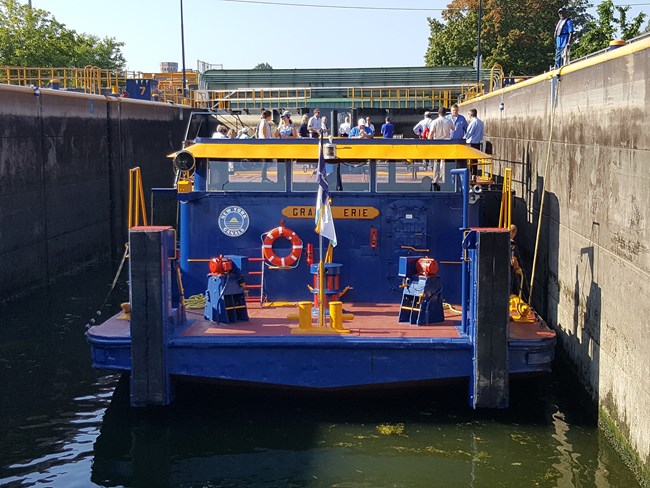“We were thrilled to join Erie Canalway National Heritage Corridor for this event. It is wonderful to see the heritage areas and community partners come together on an international stage to share their incredible work." Peter Samuel, Program Manager, NPS National Heritage Areas Program, Northeast Region
Article
Erie Canalway NHC Hosts World Canals Conference

Clinton Brown
From September 24 to 28, delegates from around the world convened in Syracuse, NY to discuss the many facets of canal development, and to learn firsthand about the engineering and economic marvel that is the Erie Canal.
As host of the 2017 World Canals Conference (WCC), Erie Canalway National Heritage Corridor (NHC) welcomed more than 420 attendees from 19 US states, five Canadian provinces, 14 countries, and three continents. Participants enjoyed dozens of presentations highlighting the latest innovations on the world’s historic waterways, as well as tours and entertainment on the waterfront. Organized around the theme, “Our Vital Waterways: Agents of Transformation”, the conference also celebrated the bicentennial anniversary of construction beginning on the Erie Canal in 1817.

NPS Photo
The WCC is an annual opportunity for canal enthusiasts, professionals, and scholars to meet and exchange best practices regarding the protection of historic canals, revitalization of canal systems, historical interpretation, and the capacity of canals to spur economic development and urban renewal.
As the hosting organization, Erie Canalway NHC was also given the chance to showcase the history and significance of their canal system. Following its completion in the mid-19th century, the Erie Canal connected the Hudson to the Niagara River, the Atlantic Ocean to the Great Lakes, opened up the West for settlement and effectively aligned New York City at the crux of domestic and international trade and commerce. This had enormous ramifications for the state and the nation as a whole. In 2000, the Canal was recognized by Congress as one of the most successful and influential feats of civil engineering in North America by receiving a National Heritage Area designation. In 2017, a National Historic Landmark (NHL) designation followed.

NPS Photo
A three-day speaker series formed the cornerstone of the event. Panelists highlighted initiatives for re-imagining the role of canals in their home communities through topics such as: canalside revitalization in Buffalo, NY; celebrating and interpreting canals through public arts and events in the Netherlands and Scotland; inspiring waterway tourism on the Sault St. Marie Canal in Ontario, Canada; the environmental clean-up and remediation of Onondaga Lake in Syracuse, NY; and the restoration of significant canal sites in Lockport, Port Byron, and Seneca Falls along the Erie Canalway.
Elissa Garafalo, Executive Director of Delaware and Lehigh NHC, lead a session about Inspiring Connections along the Delaware and Lehigh Canal.
“I was absolutely honored to have been chosen to speak,” said Garafalo. “It was a fantastic opportunity to show how Delaware and Lehigh makes the past relevant to present day by creating a sense of place distinct to our region and inspiring the stewards of the future.”

NPS Photo
Erie Canalway NHC also exhibited its rich regional history by leading participants on study tours north along the Oswego Canal, east toward where the 1817 construction began, and west to Port Byron Old Erie Canal Heritage Park and the future location of the National Women’s Hall of Fame in Seneca Falls. The tours gave visitors a glimpse into the historical assets and communities created as a result of the canal.
Although absent of the barges and schooners that once crowded its waterways, the canal continues to influence these places along the corridor. Tasked with the protection of the 524-mile corridor, the NHC provides numerous economic and recreational services to its 3.2 million residents. One new initiative spearheaded by Governor Andrew M. Cuomo will connect the 360-mile Erie Canalway Trail to the Hudson River Valley Greenway. The Empire State Trail project will make 750 continuous miles available for walking and biking between New York City, Montreal, Albany and Buffalo as the longest multi-use trail in the country.
“Congressman Tonko often talks about the canals as arteries of New York State,” said Andy Kitzman, Assistant Director of Erie Canalway NHC. “The majority of Upstate New York’s population outside of New York City is dependent on this canal system. The World Canals Conference is an incredible opportunity for us to spread the word about our work and gain new knowledge for future projects.”
Thanks to the tireless efforts of the NHC and its partners, collaborative projects like this continue to gather on the horizon. The New York Power Authority, which operates the NY State Canal System, announced during the conference kick-off that a global competition will award $2.5 million to the idea that best re-imagines the NY State Canal System to become an engine for economic growth and tourism.
Although not all canal projects take on such tremendous scale, they can be just as impactful. Julia Wleklinska, a PhD student from Gdansk, Poland, gave a presentation detailing plans to promote sustainable economic development and natural heritage preservation of a neglected portion of a Polish canal. “I am excited to gain insight from work being done in other parts of the world,” said Wleklinska. “The English and Scottish canals are my models for construction, so it was a fantastic opportunity to hear the speaker from Scottish Canals give the opening remarks.”
On the final day of the conference, a ceremonial vile of water from the Erie Canal was passed to representatives from Waterways Ireland, who will host WCC2018. The tradition passes the torch from one host to the next, symbolizing the camaraderie shared between worldwide canal communities, connected by the water they have committed to protecting.
Last updated: January 3, 2018
